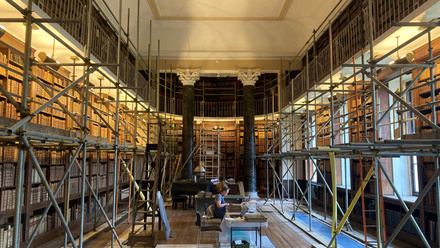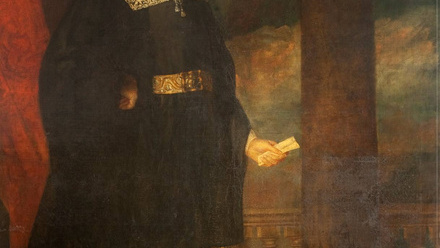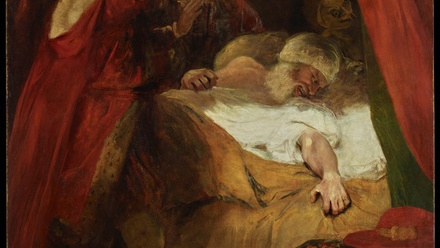Getty Museum Conserves Recently Rediscovered Painting by Artemisia Gentileschi
A recently rediscovered painting by Artemisia Gentileschi, the most celebrated woman painter of 17th century Italy, is undergoing conservation analysis and treatment at the Getty Museum. Hercules and Omphale will go on view at the end of 2023 at the Getty Center after its conservation, before returning to Sursock Palace in Beirut, Lebanon, which is currently undergoing restoration after being damaged in an explosion in 2020.
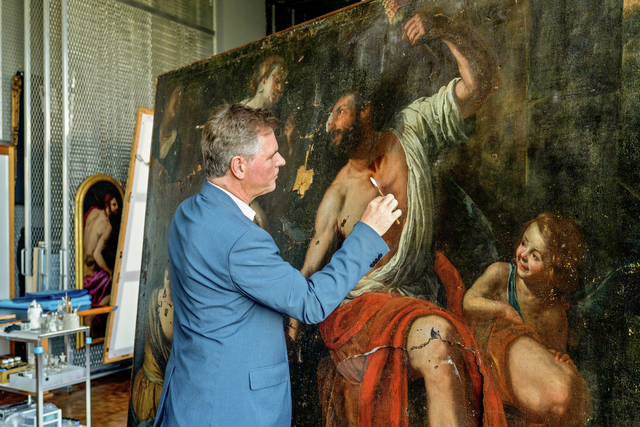
“Hercules and Omphale is one of the most important recent discoveries within the corpus of Artemisia Gentileschi, demonstrating her ambition for depicting historical subjects, something that was virtually unprecedented for a female artist in her day,” says Timothy Potts, Maria Hummer-Tuttle and Robert Tuttle Director of the J. Paul Getty Museum.
After a devastating explosion that damaged the painting, we are honored to be entrusted with its conservation and proud to showcase it at the Getty Museum once the work has been completed.
On August 4, 2020, a double explosion in the port of Beirut devasted the city, resulting in the loss of life of more than two-hundred people, and causing massive property damage, including Sursock Palace, a 19th-century mansion that was once an opulent symbol of Beirut’s cosmopolitanism and prosperity. The roof of the mansion was partially wrecked, and hundreds of pieces of furniture and art were smashed.
Months after the explosion, a Lebanese art historian, Gregory Buchakjian, published an article in Apollo Magazine about the cultural heritage loss in Beirut in which he attributed a painting in the Palace’s collection to Artemisia Gentileschi, based on previously unpublished research he’d conducted in the early 1990s. The article spurred scholarly and public interest and in April 2021 Buchakjian presented his research at a conference organized by the Medici Archive Project in Florence.
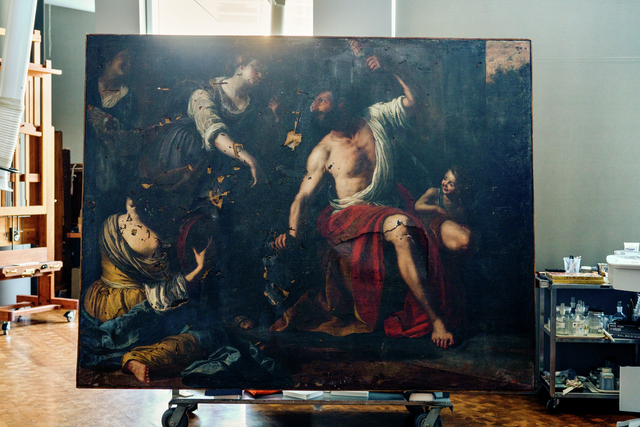
Artemisia likely painted the subject of Hercules and Omphale twice. She was commissioned to paint the first in 1628 (when she was in Venice) by Iñigo Vélez de Guevara, Conde de Oñate, on behalf of the King of Spain Philip IV. That painting is documented in an inventory of the Alcazar in Madrid in 1636 and was probably destroyed in a fire in the 18th century. Artemisia came back to the same subject a second time, over the course of her Neapolitan years (after 1630), with a composition that was probably very similar to the one she painted for the King of Spain. This second painting is recorded in the collection of Carlo de Cárdenas in 1699 in Naples and has the same measurements as the Sursock painting.
The painting depicts the Greek myth of Hercules and Omphale. As a punishment for his inadvertent murder of Iphitus, the young son of the King of Oechalia, the great hero Hercules was, by the command of the Delphic oracle, remanded as a slave to Omphale, the Queen of Lydia, for one year. Hercules was forced to do women’s work and even wear women’s clothing and hold a spindle of wool while Omphale and her maidens did their spinning. The theme, with its inversion of sexual roles, gave writers and artists ample opportunity to explore issues of gender and power.
“Hercules and Omphale is a large scale, multi-figure, complex, and ambitious composition,” explains Davide Gasparotto, senior curator of paintings at the Getty Museum. “Woman painters in the 17th century were mostly practitioners of portraiture and still life. Few dared to approach the complexity of history painting, which required a higher degree of technical skills, an appreciation of literary poetics, and knowledge of a vast body of other artworks upon which to draw. Since the inception of her career, Artemisia Gentileschi was an ambitious history painter and she competed at the same level of her male colleagues, gaining a reputation that spread all over Europe.”
“Hercules and Omphale is currently undergoing a comprehensive technical examination to develop a conservation plan that will address the severe damages caused by the explosion when glass and debris tore through the large canvas,” said Ulrich Birkmaier, senior conservator of paintings at the Getty Museum. “The devastation this painting experienced is the most serious I have ever seen, with a staggering amount of tears and paint loss, but we are working on a multi-step treatment plan that will assure that this work by Artemisia Gentileschi is once again returned to its former splendor.
After conservation treatment, the painting will go on display in E 201 (alongside the Getty’s recently acquired Lucretia) as a long-term loan from Sursock Palace, until the completion of the restoration of the building in Beirut.




